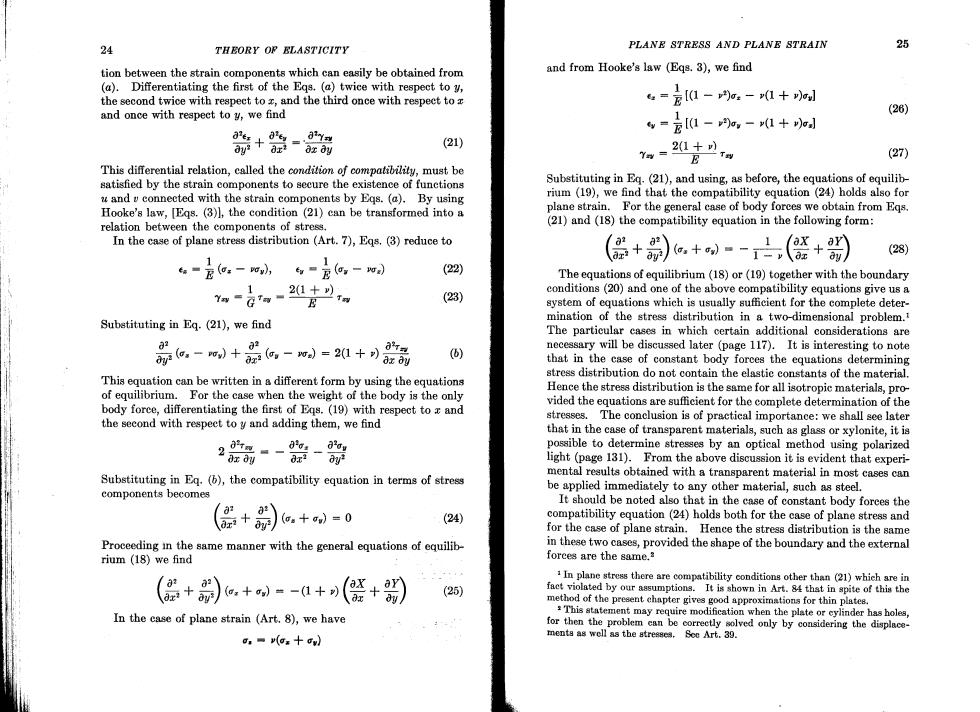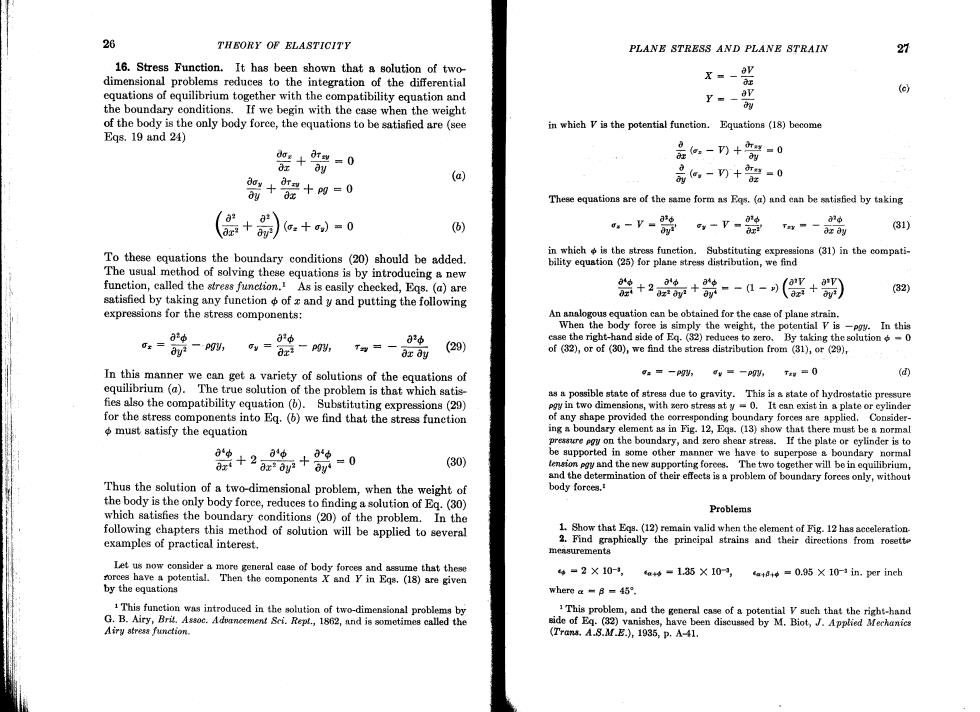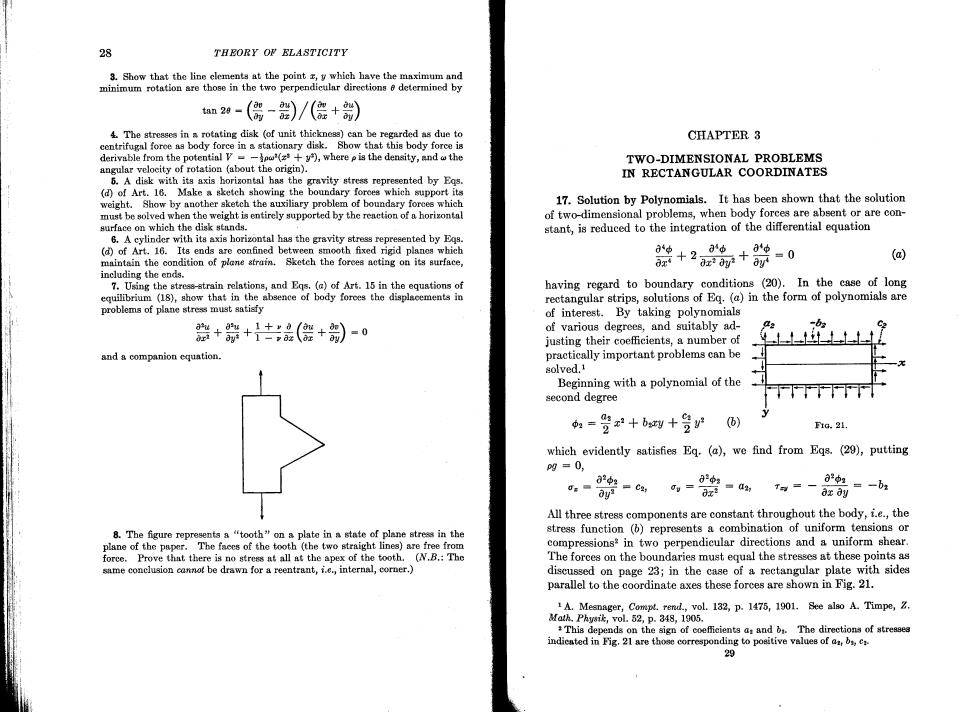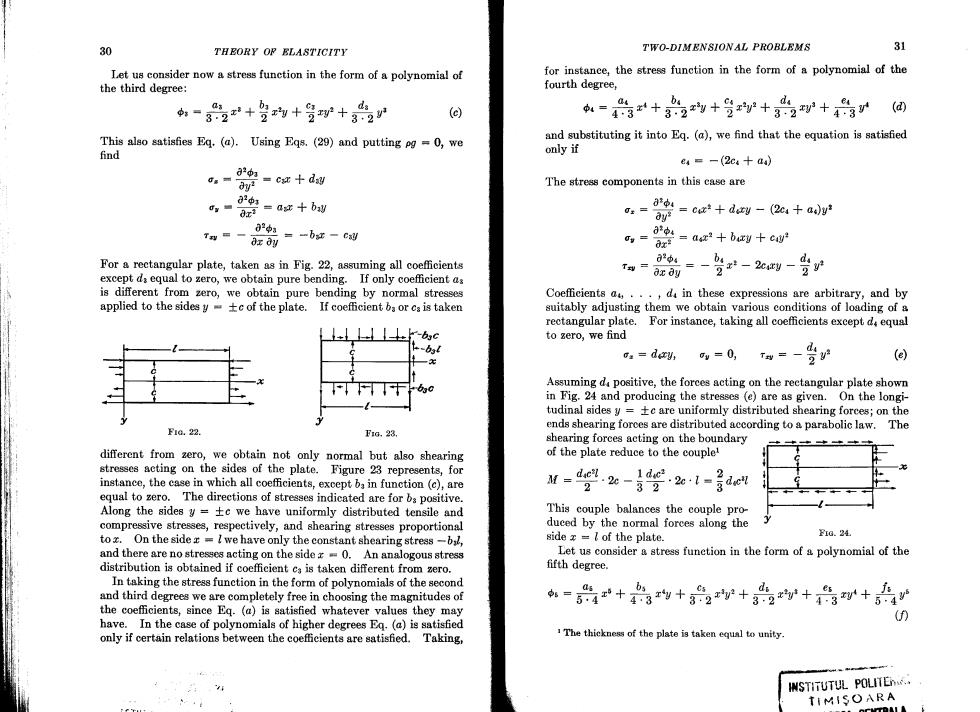
24 THEORY OF ELASTICITY PLANE STRESS AND PLANE STRAIN 25 tion between the strain components which can easily be obtained from and from Hooke's law (Eqs.3),we find (a).Differentiating the first of the Eqs.(a)twice with respect to y, 1 the second twice with respect to z,and the third once with respect to x 6=元-a:-(1+ and once with respeet to y,we find (26) 。=-网,-1+咖 箭+胎- (21) ox dy Ya=21+ E 2T到 (27) This differential relation,called the condition of compatibility,must be satisfied by the strain components to secure the existence of functions Substituting in Eq.(21),and using,as before,the equations of equilib- u and y connected with the strain components by Eqs.(a).By using rium (19),we find that the compatibility equation (24)holds also for Hooke's law,[Eqs.(3)1,the condition (21)can be transformed into a plane strain.For the general case of body forces we obtain from Eqs. relation between the components of stress. (21)and(18)the compatibility equation in the following form: In the case of plane stress distribution (Art.7),Eqs.(3)reduce to (+)+-亡,(船+) a (28) 4-2o.-女-言o,- (22) The equations of equilibrium(18)or(19)together with the boundary 8m-2#n 1 conditions (20)and one of the above compatibility equations give us a Yay (23) system of equations which is usually sufficient for the complete deter- Substituting in Eq.(21),we find mination of the stress distribution in a two-dimensional problem. The particular cases in which certain additional considerations are o,-w+器6,-=20+ a2 (⑥) necessary will be discussed later (page 117).It is interesting to note ox oy that in the case of constant body forces the equations determining This equation can be written in a different form by using the equations stress distribution do not contain the elastic constants of the material. of equilibrium.For the case when the weight of the body is the only Hence the stress distribution is the same for all isotropic materials,pro- body foree,differentiating the first of Eqs.(19)with respect to x and vided the equations are sufficient for the complete determination of the the second with respect to y and adding them,we find stresses.The conclusion is of practical importance:we shall see later that in the case of transparent materials,such as glass or xylonite,it is possible to determine stresses by an optical method using polarized ax oy light(page 131).From the above discussion it is evident that experi- Substituting in Eq.(b),the compatibility equation in terms of stress mental results obtained with a transparent material in most cases can components becomes be applied immediately to any other material,such as steel. It should be noted also that in the case of constant body forees the 02 0x2 (ca十)=0 (24) compatibility equation (24)holds both for the case of plane stress and for the case of plane strain.Hence the stress distribution is the same Proceeding in the same manner with the general equations of equilib- in these two cases,provided the shape of the boundary and the external rium (18)we find forees are the same. (品+别).+,=-1+(+》 iIn plane stress there are compatibility conditions other than (21)which are in (25) fact violated by our assumptions.It is shown in Art.84 that in spite of this the method of the present chapter gives good approximations for thin plates. In the case of plane strain (Art.8),we have This statement may require modification when the plate or eylinder has holes, for then the problem ean be correetly solved only by considering the displace- a,■(gx十cg】 menta as well as the stresses.See Art.39

26 THEORY OF ELASTICITY PLANE STRESS AND PLANE STRAIN 27 16.Stress Function.It has been shown that a solution of two- dimensional problems reduces to the integration of the differential X=- av dx ap (e equations of equilibrium together with the compatibility equation and Y=- the boundary conditions.If we begin with the case when the weight 剂 of the body is the only body foree,the equations to be satisfied are (see in which V is the potential function.Equations (18)become Eqs.19 and 24) 0 十 o-刀+密-0 dx r型=0 a (a) 0y十3 品o,-m+能-0 ay g十pg=0 These equations are of the same form as Eqs.(a)and ean be satisficd by taking a24 (o:十a)=0 (6) .-V- -v-器 Tn”一好y (31) To these equations the boundary conditions (20)should be added. in which is the stress function.Substituting expressions (31)in the compati- bility equation (25)for plane stress distribution,we find The usual method of solving these equations is by introducing a new function,called the stress function.As is easily checked,Egs.(a)are 2+、 胎+2 -a-(g+别) (32) satisfied by taking any function of z and y and putting the following expressions for the stress components: An analogous equation can be obtained for the case of plane strain. When the body foree is simply the weight,the potential V is -pgy.In this a* 0x= ays-pgy, -28-咖 a26 case the right-hand side of Eq.(32)reduces to zero.By taking the solution0 T=一 axa划 (29) of (32),or of (30),we find the stress distribution from (31),or (29) In this manner we can get a variety of solutions of the equations of a=一Pyy, y=-p0,Tg=0 (d) equilibrium (a).The true solution of the problem is that which satis- asa possible stnte of atress due to gravity.This is a state of hydrostatie pressure fies also the compatibility equation().Substituting expressions(29) pgy in two dimensions,with xero stress at y =0.It can exist in a plate or eylinder for the stress components into Eq.(6)we find that the stress funetion of any shape provided the corresponding boundary forces are applied.Consider- must satisfy the equation ing a boundary element as in Fig.12,Egs.(13)show that there must be a normal pressure agy on the boundary,and zero shear stress.If the plate or eylinder is to +2,06 0中 0+游=0 be supported in some other manner we have to superpose s boundary normal (30) lension pgy and the new supporting forees.The two together will be in equilibrium, and the determination of their effects is a problem of boundary forces only,without Thus the solution of a two-dimensional problem,when the weight of body forees. the body is the only body force,reduces to finding a solution of Eq.(30) which satisfies the boundary conditions(20)of the problem.In the Problems following chapters this method of solution will be applied to several 1.Show that Eqa.(12)remain valid when the element of Fig.12 has acceleration. examples of practical interest. 2.Find graphically the principal strains and their directions from roeette measurements Let us now consider a more general case of body forces and assume that these rorces have a potential.Then the components X and Y in Eqs.(18)are given 4-2X10,m4=1.35×10, a=0.95 X 10-in.per inch by the equations where a B-45. 1This function was introduced in the solution of two-dimensional problems by 1This problem,and the general case of a potential V such that the right-hand G.B.Airy,Brit.Assoc.Aduancement Sci.Rept,1862,and is sometimes called the side of Eq.(32)vanishes,have been discussed by M.Biot,J.Applied Mechanics Ary8fres特Function. (Trans,.A.S.M.E.),1935,p.h-41

28 THEORY OV ELASTICITY 3.Show that the line clements at the point r,y which have the maximum and minimum rotation are those in the two perpendicular directions determined by am2a-(偶-)/(偏+) 4.The stresses in a rotating disk (of unit thickness)can be regarded as due to CHAPTER 3 centrifugnl foree as body force in a stationary disk.Sbow that this body force is derivable from the potentinl V-(+y),where p is the density,and w the TWO-DIMENSIONAL PROBLEMS angular velocity of rotation (about the origin). IN RECTANGULAR COORDINATES 5.A disk with its axis horixontal has the gravity stress represented by Egs. (d)of Art.16.Make a sketeh showing the boundary forees which support its weight.Show by another sketch the auxiliary problem of boundary forces which 17.Solution by Polynomials.It has been shown that the solution must be solved when the weight is entirely supported by the renction of a horizontal of two-dimensional problems,when body forces are absent or are con- surface on which the disk stands. stant,is reduced to the integration of the differential equation 6.A cylinder with its axis horizontal has the gravity stress represented by Egs. (d)of Art.16.Its ends are confined between smooth fixed rigid planes which (a) maintain the condition of plane strain.Sketeh the forces acting on its surface, 器+2" ,地=0 a7+时 including the ends. 7.Using the stress-strain relations,and Eqs.(a)of Art.15 in the equations of having regard to boundary conditions (20).In the case of long equilibrium (18),show that in the absence of body forces the displacements in rectangular strips,solutions of Eq.(@in the form of polynomials are problems of plane stress must satisfy of interest.By taking polynomials 器++:品(+)=0 of various degrees,and suitably ad- justing their coefficients,a number of and a companion equation. practically important problems can be solved.1 Beginning with a polynomial of the second degree =受2+b6y+气y 6) Fta.21. which evidently satisfies Eq.(a),we find from Eqs.(29),putting 9=0, 0e= 的9=C: 0= 8整=041 T可=一 82虹=一bm ox dy All three stress components are constant throughout the body,i.e.,the 8.The figure represents a "tooth"on a plate in a state of plane stress in the stress function (b)represents a combination of uniform tensions or plane of the paper.The faces of the tooth (the two straight lines)are free from compressions*in two perpendicular directions and a uniform shear. force.Prove that there is no stress at all at the apex of the tooth.(N.B.:The The forces on the boundaries must equal the stresses at these points as same conclusion cannot be drawn for a reentrant,i.e.,internal,corner.) discussed on page 23;in the case of a rectangular plate with sides parallel to the coordinate axes these forces are shown in Fig.21. 1A.Mesnager,Compt.rend.,vol.132,p.1475,1901.See also A.Timpe,Z. Math.Physik,vol.52,p.348,1905. This depends on the sign of coefficients a and.The directions of stressea indieated in Fig.21 are those corresponding to positive values ofc 29

30 THEORY OF ELASTICITY TWO-DIMENSIONAL PROBLEMS 31 Let us consider now a stress function in the form of a polynomial of for instance,the stress function in the form of a polynomial of the the third degree: fourth degree, 一82+号+号到+32 04 (e) =3+02+号y+3品2+3护 (d) This also satisfies Eq.(a).Using Eqs.(29)and putting pg =0,we and substituting it into Eq.(a),we find that the equation is satisfied find only if e4=-(2c4十aa a.cdy /2 The stress components in this case are g■ 82虹 x=as+bay os==cue:+dory -(2cs asy 823 Ta▣一0证y =-bst-cx gm=g=ax2+b划十cw For a rectangular plate,taken as in Fig.22,assuming all coefficients except d:equal to zero,we obtain pure bending.If only coefficient as n=那8新=-告-20-受r 02中4 da is different from zero,we obtain pure bending by normal stresses Coefficients a...,d in these expressions are arbitrary,and by applied to the sides ytc of the plate. If coefficient ba or cs is taken suitably adjusting them we obtain various conditions of loading of a rectangular plate.For instance,taking all coefficients except d equal w-b3c to zero,we find a=dey, w=0,m=-受 (e) Assuming d positive,the forces acting on the reetangular plate shown in Fig.24 and producing the stresses (e)are as given.On the longi- tudinal sides y=tc are uniformly distributed shearing forees;on the ends shearing forces are distributed according to a parabolic law.The F1G.22. F1G,23, shearing forces acting on the boundary different from zero,we obtain not only normal but also shearing of the plate reduce to the couplet stresses acting on the sides of the plate.Figure 23 represents,for M=2-专% 1 ducz 2 instance,the case in which all coefficients,except ba in function (c),are 2 .20.1-gdo equal to zero.The directions of stresses indicated are for bs positive. Along the sides y=tc we have uniformly distributed tensile and This couple balances the couple pro- compressive stresses,respectively,and shearing stresses proportional dueed by the normal forces along the to z.On the side x =I we have only the constant shearing stress-bl, side z =7 of the plate. 10.24 and there are no stresses acting on the side x0.An analogous stress Let us consider a stress funetion in the form of a polynomial of the distribution is obtained if coefficient cs is taken different from zero. fifth degree. In taking the stress function in the form of polynomials of the second and third degrees we are completely free in choosing the magnitudes of =写4++2+2+3十 the coefficients,since Eq.(a)is satisfied whatever values they may have.In the case of polynomials of higher degrees Eq.(a)is satisfied n only if certain relations between the coefficients are satisfied.Taking, The thickness of the plate is taken equal to unity. INSTITUTUL POLITE. TIMISOARA

32 THEORY OP ELASTICITY TWO-DIMENSIONAL PROBLEMS 33 Substituting in Eq.(a)we find that this equation is satisfied if 18.Saint-Venant's Principle.1 In the previous article several cases e6=-(2cs十3a) were discussed in which exact solutions for rectangular plates were f6=-(b.+2d) obtained by taking very simple forms for the stress function In each case all the equations of elasticity are satisfied,but the solutions The corresponding stress components are: are exact only if the surface forces are distributed in the manner given. -0-号+dy-a+3ay-言0a+20 In the case of pure bending,for instance (Fig.22),the bending moment must be produced by tensions and compressions on the ends,these oya+buxy+cuxy+y tensions and compressions being proportional to the distance from the neutral axis.The fastening of the end,if any,must be such as not to 0=-意如-6e-dar+2a,+3a沙 0p6 interfere with distortion of the plane of the end.If the above condi- tions are not fulfilled,ie.,the bending moment is applied in some different manner or the constraint is such that it imposes other forees Again coefficients as,...,ds are arbitrary,and in adjusting them on the end section,the solution given in Art.17 is no longer an exact we obtain solutions for various loading conditions of a plate.Taking, solution of the problem.The practical utility of the solution however is not limited to such a specialized case.It can be applied with suffi- cient accuracy to cases of bending in which the conditions at the ends are not rigorously satisfied.Such an extension in the application of the solution is usually based on the so-called principle of Saint-Venant. s-c-c3 This principle states that if the forces acting on a small portion of the surface of an elastic body are replaced by another statically equivalent system of forces acting on the same portion of the surface,this redis- a f6) F10.25. tribution of loading produces substantial changes in the stresses locally but has a negligible effect on the stresses at distances which are large in for instance,all coefficients,except ds,equal to zero we find comparison with the linear dimensions of the surface on which the o==d6(xy-y) forces are changed.For instance,in the case of pure bending of a Oy =dsyi (g) rectangular strip (Fig.22)the cross-sectional dimensions of which are Tn =-dsty2 small in comparison with its length,the manner of application of the external bending moment affects the stress distribution only in the The normal forces are uniformly distributed along the longitudinal vicinity of the ends and is of no consequence for distant cross sections, sides of the plate (Fig.25a).Along the side z=,the normal forces at which the stress distribution will be practically as given by the solu- consist of two parts,one following a linear law and the other following tion to which Fig.22 refers. the law of a cubie parabola.The shearing forces are proportional to x The same is true in the case of axial tension.Only near the loaded on the longitudinal sides of the plate and follow a parabolic law along end does the stress distribution depend on the manner of applying the the sidex=L.The distribution of these stresses is shown in Fig.256. tensile force,and in cross sections at a distance from the end the Since Eq.(a)is a linear differential equation,it may be concluded stresses are practically uniformly distributed.Some examples illus- that a sum of several solutions of this equation is also a solution.We trating this statement and showing how rapidly the stress distribution can superpose the elementary solutions considered in this article and becomes practically uniform will be discussed later (see page 52). in this manner arrive at new solutions of practical interest.Several examples of the application of this method of superposition will be This principle was stated in the famous memoir on torsion in Mem.sants drangers,vol.14,1855.Its relation to the prineiple of conservation of energy is considered. diseussed later(see p.150)